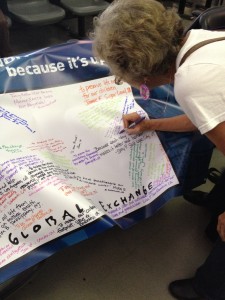 The familiar yet snarky refrain plays in my head: “It seems that all you climate activists are always flying in planes all over the world to save the environment.” The irony of relying on speedy and convenient fossil-fuel intensive transportation in the urgent pursuit of saner environmental policies is not lost on anyone who has ever hopped from one international meeting to the next.
The familiar yet snarky refrain plays in my head: “It seems that all you climate activists are always flying in planes all over the world to save the environment.” The irony of relying on speedy and convenient fossil-fuel intensive transportation in the urgent pursuit of saner environmental policies is not lost on anyone who has ever hopped from one international meeting to the next.
But as I thought about my own reasons for attending the People’s Climate March, coinciding with the gathering of world leaders at the UN to address climate chaos, boarding the so-called Climate Train seemed like the only way to go; maybe even the best reason to go to New York.

Shannon Biggs boards the Climate Train in Emeryville, CA.
As a believer in the idea that communities hold the key to creating change, I’m not headed to New York to speak truth to power before the United Nations or our politicians — though for many that is why they are going. I come to hold space for people fighting for change in the places where they live—communities asserting their rights to ban the incinerator by the school grounds, or the industrial hog farm where community farming once stood, a fracking site that threatens their water and air; First Nations people blockading the machines of destruction. If our politicians are ever going to act, it’s going to be because people took action first to protect local ecosystems and the people that they love.
So, with some encouragement, I took the train to slow down a little and share the stories and learnings of people all along the way. It’s been a journey already. When we boarded in the Bay Area, we were 120 climate riders strong, as we chug through the endless fields of (largely) GMO corn on our way to Chicago, we’ve picked up another 60 riders.

The Climate Train was greeted by rallies across the country (this one in Reno, NV).
At most stops there is a rally, where local people come out to cheer us on, thank us for taking the journey and asking us to carry their messages with us to New York. They tell us they are so grateful for we riders, and we tell them we’re grateful for them, staying at home where ground zero for the climate fight is and doing what they do—stand their ground and create the change at home.
I will be teaching 2 workshops on the train, on Community Rights and Rights of Nature, to share the lessons of hundreds of communities who have chosen to pass binding laws that place the rights of people and ecosystems over corporate interests. People are excited to learn about this framework, and all of the other work and perspectives being exchanged over the days. Other workshops range from examining race and classism in the climate movement, to building the climate movement within movements of faith, and dozens more. Riders come from all backgrounds, ages, and starting points—everyone on the Train has something to share, and something to take away.
In Denver a dozen new riders, including Susan Reiderer, a mother and grandmother who is relatively new to working on climate issues, joined us. She joined Citizens Climate Lobby two years ago to “stand up to power and do whatever it takes.” She added that although she loves the work she’s doing through CCL, she thinks doing whatever it takes probably “means that we have to do civil disobedience.” She’s ready.

Conversations on the Climate Train.
Back on board the Train, at any time of day people can be found in sleeping bags napping, creating music in small groups, some are creatively cooking together with crock pots and rice cookers or bustling through the pricier dining cars, attending one of the nearly non-stop workshops, or getting to know each other in the observation deck where the alternating beauty and ravages surround us with breathtaking clarity. This is the way to see the country, and to get inspired for the change that is possible.

Shannon and Pennie’s first night on the Climate Train.
Early on in the journey I was sitting in our tiny shared “sleeper-ette” room with my friend and ally Pennie Opal Plant as we looked at the beautiful Sierras through a brown haze of smoke—one of many forest fires in our drought-ridden state this year. Lamenting the magnitude of change needed can get even the most buoyant activist down at times. There, in the middle of nowhere (if nowhere is a majestic forest grove along the train tracks with no nearby roads) was a small group of people beside the tracks, excitedly holding signs for us as we chugged past. We waved to them and they to us, and something quite beautiful transferred between us all.
I looked over to Pennie, who was similarly overcome with emotion. “It was the simple act of someone holding a sign,” she said. “I felt the magnitude of humanity responding to Mother’s Earth’s call to rise up as her immune response in defense of future generations of life as we know it within our biosphere. I was overwhelmed with joy.”
If the train has reinforced anything for me it is that we were not in this alone, we are here for each other. Once the crowds and chaos of the march in the streets of New York have died down, and we all return home to continue the work, it may be that the experience on the Climate Train has given us the best new ideas to work with and new allies to keep us going.


